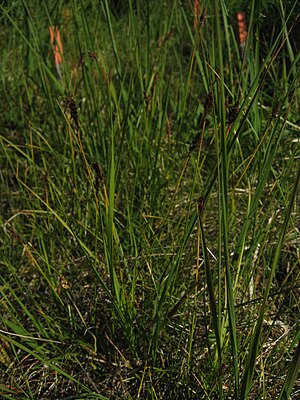Two-part barn sedge
| Two-part barn sedge | ||||||||||||
|---|---|---|---|---|---|---|---|---|---|---|---|---|

Two-part scallop sedge ( Kobresia simpliciuscula ) |
||||||||||||
| Systematics | ||||||||||||
|
||||||||||||
| Scientific name | ||||||||||||
| Kobresia simpliciuscula | ||||||||||||
| ( Wahlenb. ) Mack. |
The two-part Schuppenried ( Kobresia simpliciuscula (Wahlenb.) Mack. , Syn .: Carex simpliciuscula Wahlenb. ), Also called Seggen-Schuppenried , two-part Schuppenried or Kobresie , is a species of the Schuppenseggen ( Kobresia ) within the sourgrass family ( Cyperaceae). It is widespread in the northern hemisphere .
description
The two-part scallop sedge is a perennial herbaceous plant that reaches heights of 3 to 20, up to 30 centimeters. It grows like a lawn . The rigidly upright stems are about 1 mm thick, smooth or only a little rough at the top, almost stalk-round or indistinctly triangular. The leaf sheaths are light brown and dull. The leaf blades are narrow, up to about 2 mm wide, shorter than the stem and rough on the edge.
The flowering period is between July and August. The terminal inflorescence is 1 to 3 centimeters long and composed of tightly packed ears, each of which is composed of several spikelets. The spikelets are female at the base, male in the upper part. The bract of the lowest ear often has a leaf-like tip and is as long as the ear. The bracts of the single-flowered spikelets are about 4 mm long, keeled, red-brown and white-skinned on the edge. The male flowers contain three stamens . The female flowers contain three stigmas . The fruit is spiky on the rest of the style and about 3 mm long.
The number of chromosomes is 2n = 76.
Occurrence
Kobresia simpliciuscula is widespread in the northern hemisphere . The wide distribution area extends from northern Europe , the Pyrenees , Alps and the Carpathians to the Caucasus and from subarctic North America with Greenland to the western United States.
It is considered an Ice Age relic in Central Europe . Overall, it is very rare in Central Europe and is absent in large areas there. However, it usually forms smaller stocks at its locations, for example in the Valais , in the Bernese Oberland , in Graubünden in the Berchtesgaden Alps , in the Hohe Tauern and in Upper Styria .
In Central Europe it prefers altitudes between about 1700 and 2500 meters. It thrives in the Alps at altitudes between 1,300 and 2,620 meters.
The two-part scale sedge thrives best on trickled, base-rich and mostly calcareous , loose on soaky, gravel or sand soils . She endures cold. In Central Europe it occurs only on soaked slopes, on gravelly or sandy banks of alpine streams and gullies. The kobresia simpliciuscula comes in a total area of distribution source corridors in fens , on gravel banks before. Kobresia simpliciuscula is a Kennart of Kobresietum simpliciusculae from the Association Caricion bicolori-atrofuscae.
Taxonomy
The first publication took place in 1803 by the Swedish botanist Göran Wahlenberg under the name ( Basionym ) Carex simpliciuscula . Other synonyms for Kobresia simpliciuscula (Wahlenb.) Mack. are: Kobresia caricina Willd. , Kobresia bipartita (All.) Dalla Torre .
literature
- Wolfram Schultze Motel: Kobresia. , Pp. 92-96. In: Gustav Hegi: Illustrated flora of Central Europe. Volume II, part 1. 3rd edition. Paul Parey, Berlin / Hamburg 1967-1975, ISBN 3-489-54020-4 .
- Arthur Oliver Chater: Kobresia. , Pp. 289-290 In: TG Tutin et al .: Flora Europaea . Volume 5. Cambridge University Press, 1980, ISBN 0-521-20108-X .
- Peter William Ball: Kobresia. : Kobresia simpliciuscula , p. 252 - the same text online as the printed work , In: Flora of North America Editorial Committee (Ed.): Flora of North America North of Mexico. Volume 23: Magnoliophyta: Commelinidae (in part): Cyperaceae , Oxford University Press, New York and Oxford, 2002, ISBN 0-19-515207-7 .
- Erich Oberdorfer : Plant-sociological excursion flora for Germany and neighboring areas. With the collaboration of Angelika Schwabe, Theo Müller. 8th, heavily revised and expanded edition. Eugen Ulmer, Stuttgart (Hohenheim) 2001, ISBN 3-8001-3131-5 .
Individual evidence
- ↑ Kobresia simpliciuscula (Wahlenb.) Mack., Seggen-Schuppenried. In: FloraWeb.de.
- ^ Tropicos. [1]
- ↑ Rafaël Govaerts (Ed.): Carex simpliciuscula. In: World Checklist of Selected Plant Families (WCSP) - The Board of Trustees of the Royal Botanic Gardens, Kew . Retrieved October 25, 2016.
- ↑ a b c d e Dietmar Aichele, Heinz-Werner Schwegler: The flowering plants of Central Europe . 2nd Edition. tape 5 : Swan flowers to duckweed plants . Franckh-Kosmos, Stuttgart 2000, ISBN 3-440-08048-X .
- ^ Erich Oberdorfer : Plant-sociological excursion flora for Germany and neighboring areas . With the collaboration of Angelika Schwabe and Theo Müller. 8th, heavily revised and expanded edition. Eugen Ulmer, Stuttgart (Hohenheim) 2001, ISBN 3-8001-3131-5 , pp. 167 .
Web links
- Two-part barn sedge. In: FloraWeb.de.
- Two-part barn sedge . In: BiolFlor, the database of biological-ecological characteristics of the flora of Germany.
- Profile and distribution map for Bavaria . In: Botanical Information Hub of Bavaria .
- Kobresia simpliciuscula (Wahlenb.) Mack., Map for distribution in Switzerland In: Info Flora , the national data and information center for Swiss flora .
- Distribution in the northern hemisphere from: Eric Hultén , Magnus Fries: Atlas of North European vascular plants 1986, ISBN 3-87429-263-0 at Den virtuella floran (swed.)
- Thomas Meyer: Data sheet with identification key and photos at Flora-de: Flora von Deutschland (old name of the website: Flowers in Swabia )
- Photos: [2] , [3] , gloria.ac.at ( Memento from March 4, 2016 in the Internet Archive ), [4] , [5]
